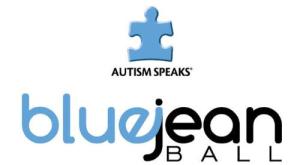PRESENTED BY THE GUESS? FOUNDATION, WITH SPECIAL PERFORMANCES BY JAMES DURBIN, RICK SPRINGFIELD, RYAN BINGHAM, HONORING CHUCK SAFTLER OF FX NETWORKS
Hosted by Extra’s Maria Menounos and Actor Michael Chiklis
LOS ANGELES, CA, October 20, 2013 – Grammy® Award-winning music legend Dave Grohl
will headline Autism Speaks’ Third Annual BLUE JEAN BALL, presented by The GUESS?
Foundation, on Thursday, October 24, 2013, at Boulevard 3 in Hollywood.
Dave Grohl is the lead vocalist, guitarist, and main songwriter for the Foo Fighters, a band he
founded after being the drummer for the American grunge band Nirvana. Grohl is an eleven-
time Grammy® winner, and was Grammy®-nominated a total of 25 times. He has also taken
home an American Music Award and two MTV Music Video Awards.
Also performing will be rock artist Rick Springfield, who won a Grammy® for his No. 1 hit
“Jessie’s Girl” in 1981 and received an additional three Grammy® nominations. Oscar® and
Grammy®-winning artist Ryan Bingham will be performing as well. He recently wrote and
recorded “Until I’m One With You,” the theme-song for FX’s drama-series, The Bridge. Bingham
performed and co-wrote Crazy Heart’s (2009) award-winning theme song “The Weary Kid,”
earning him an Oscar, Grammy, Golden Globe, and Critics Choice Award, with the American
Music Association naming him “Artist of the Year.”
Also taking the stage will be American Idol finalist James Durbin, who is recognized for placing
in the top four of Season 10, while openly sharing his challenges of living with Aspergers
and Tourettes. In addition, The White Buffalo with singer/songwriter Jake Smith (Shadows,
Greys and Evil Ways) will perform. World-renowned DJ Splyce will be providing entertainment
throughout the evening.
The Third Annual BLUE JEAN BALL is honoring Chuck Saftler, President of Program Strategy
and Chief Operating Officer of FX Networks, and Autism Speaks Board of Directors’ Member.
Saftler will receive the tribute for his dedication to autism awareness. Hosting the event will be
television personality Maria Menounos (Extra) and Emmy® Award-winning Actor Michael Chiklis
(The Shield, Vegas, The Commish).
The Autism Speaks BLUE JEAN BALL is dedicated to raising awareness and funds for
innovative autism research and resources for individuals and families affected by the
disorder. Tickets, sponsorship opportunities and additional information are available at
events.autismspeaks.org/bluejeanball.
“One in 88 children is currently diagnosed with autism, and the annual cost for families living
with the disorder is an average of $60,000,” stated Matt Asner, Executive Director of Southern
California for Autism Speaks. “Now, more than ever, we need to raise awareness and assure
that research, advocacy and family service initiatives continue to be funded. What better way to
make a little noise than with a rock and roll concert?”
Past participants and honorees have included Sarah McLachlan, Toni Braxton, Paul Marciano,
photographer Rob Shanahan, Sinbad, Brooke White, Raphael Saadiq, Sarah Shahi, Beth
Reisgraph, Nikki Reed and Paul MacDonald, among others.
Autism is a general term used to describe a group of complex developmental brain disorders – autism
spectrum disorders – caused by a combination of genes and environmental influences. These disorders
are characterized, in varying degrees, by communication difficulties, social and behavioral challenges, as
well as repetitive behaviors. An estimated one in 88 children in the U.S. is on the autism spectrum – a 78
percent increase in six years that is only partly explained by improved diagnosis.
About Autism Speaks
Autism Speaks is the world’s leading autism science and advocacy organization. It is dedicated to funding
research into the causes, prevention, treatments and a cure for autism; increasing awareness of autism
spectrum disorders; and advocating for the needs of individuals with autism and their families. Autism
Speaks was founded in February 2005 by Suzanne and Bob Wright, the grandparents of a child with
autism. Mr. Wright is the former vice chairman of General Electric and chief executive officer of NBC
and NBC Universal. Since its inception, Autism Speaks has committed nearly $200 million to research
and developing innovative resources for families. Each year Walk Now for Autism Speaks events are
held in more than 100 cities across North America. On the global front, Autism Speaks has established
partnerships in more than 40 countries on five continents to foster international research, services and
awareness. To learn more about Autism Speaks, please visit http://www.AutismSpeaks.org .
Established in 1981, GUESS began as a jeans company and has since successfully grown into a global
lifestyle brand. Today, GUESS designs, markets and distributes full collections of women’s, men’s
and children’s apparel as well as accessories. Throughout the years, the GUESS image has been
portrayed in unforgettable, innovative campaigns that have made the brand a household name. GUESS
is distributed throughout the United States and Canada in fine department stores, its retail specialty and
factory stores, and domestically on its online stores. GUESS has licensees and distributors in South
America, Europe, Asia, Africa and Australia. In addition to shopping online, you can find more information
on GUESS at http://www.guess.com.





You must be logged in to post a comment.